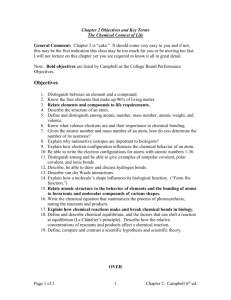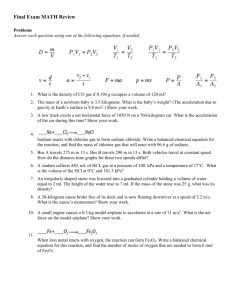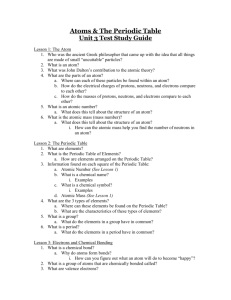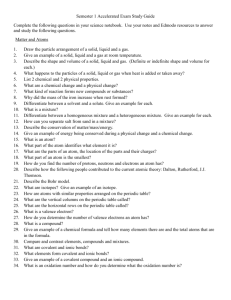Physical Science Final Exam Review Worksheet
advertisement
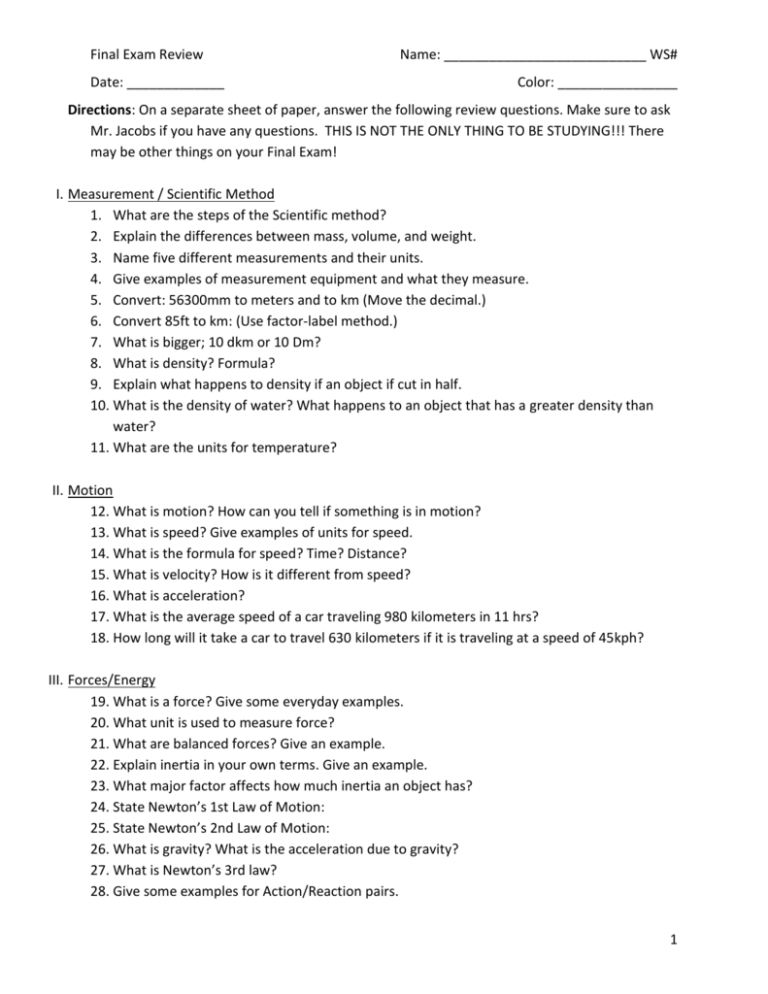
Final Exam Review Name: ___________________________ WS# Date: _____________ Color: ________________ Directions: On a separate sheet of paper, answer the following review questions. Make sure to ask Mr. Jacobs if you have any questions. THIS IS NOT THE ONLY THING TO BE STUDYING!!! There may be other things on your Final Exam! I. Measurement / Scientific Method 1. What are the steps of the Scientific method? 2. Explain the differences between mass, volume, and weight. 3. Name five different measurements and their units. 4. Give examples of measurement equipment and what they measure. 5. Convert: 56300mm to meters and to km (Move the decimal.) 6. Convert 85ft to km: (Use factor-label method.) 7. What is bigger; 10 dkm or 10 Dm? 8. What is density? Formula? 9. Explain what happens to density if an object if cut in half. 10. What is the density of water? What happens to an object that has a greater density than water? 11. What are the units for temperature? II. Motion 12. What is motion? How can you tell if something is in motion? 13. What is speed? Give examples of units for speed. 14. What is the formula for speed? Time? Distance? 15. What is velocity? How is it different from speed? 16. What is acceleration? 17. What is the average speed of a car traveling 980 kilometers in 11 hrs? 18. How long will it take a car to travel 630 kilometers if it is traveling at a speed of 45kph? III. Forces/Energy 19. What is a force? Give some everyday examples. 20. What unit is used to measure force? 21. What are balanced forces? Give an example. 22. Explain inertia in your own terms. Give an example. 23. What major factor affects how much inertia an object has? 24. State Newton’s 1st Law of Motion: 25. State Newton’s 2nd Law of Motion: 26. What is gravity? What is the acceleration due to gravity? 27. What is Newton’s 3rd law? 28. Give some examples for Action/Reaction pairs. 1 29. How much force does a 6700 kg cart have, accelerating at a rate of 84m/s2? 30. What is the mass of a falling ball because of gravity (-9.8 m/s2) if it hits the ground with a force of 5678 N? 31. What is momentum, and when does an object have momentum? 32. What is the difference(s) between Potential and Kinetic Energy? 33. Give an example of potential energy converting to kinetic energy. 34. What is the law of conservation of energy? IV. Matter 35. What is the basic unit of matter? 36. What are the 3 parts of an atom? What are their charges? 37. Calculate the volume of a liquid with a density of 0.45g/ml and a mass of 76 g . 38. If a 67.5 g object takes up a volume of 3456 cm3, what is its density? 39. What is the mass of a liquid with a density of 2.3g/ml and a volume of 45ml? 40. What is matter? Give examples of some properties of matter. 41. What is the difference between a compound and a mixture? Give an example of each. 42. What are the two types of pure substances? Give examples. 43. What are the two types of mixtures? Give examples. 44. What are the two types of heterogeneous mixtures? Give examples. 45. What is the Tyndall Effect? 46. Give three example of a physical change. 47. Give three example of a chemical change. 48. Give five examples of physical properties. 49. Give three examples of chemical properties. 50. Give and explain the six types of phase changes. 51. Define exothermic and endothermic and give examples of phase changes for each. 52. What are the major differences between solids, liquids, and gases? 53. Name the different changes in states of matter. (Give examples for each.) V. Atoms and the Periodic Table 54. What information can you get from the atomic number of an element? 55. How is the atomic mass different from the atomic number of an element? 56. How can you calculate the number of neutrons in an atom? 57. What are valence electrons? Why are they so important? 58. Where are the metals located? 59. Where are the metalloids located? 60. Where are the nonmetals located? 61. Draw an atom for Iodine. 2 62. How many neutrons are in Ca-41? VI. Chemical Bonds and Equations: 63. What is the main difference between how an ionic bond forms and how a covalent bond forms? 64. What types of elements are in an ionic bond? 65. What types of elements are in a covalent bond? 66. How can you determine the number of bonds that an element can make? 67. What are the 3 major properties of ionic compounds? 68. What are the 2 major properties of covalent (molecular) compounds? 69. What causes water to come together when it is spilled? 70. Draw Bohr diagrams for: B, Na, Ne 71. Draw Lewis structures for: S, He, Al, Ba and Li 72. Draw Lewis structures for: NH3, NaCl and CF4 73. Write the chemical equation for photosynthesis and label the coefficients, subscripts, products and reactants. 74. Balance the following equations: Fe + H2O →Fe3O4 + H2 Na2SO4 + CaCl2→CaSO4 + NaCl Physical Science Final Review Formula Sheet Directions: Find and Record the formulas and units! VII. Measurement / Scientific Method 75. Density, Mass, Volume VIII. Motion 76. Speed, Distance, Time IX. Forces 77. Force, Mass, Acceleration 78. Momentum, Mass, Velocity X. Matter, Atoms, and the Periodic Table 79. # of Neutrons 80. Average Atomic Mass 3


